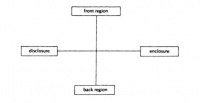Regionalisation
From Geography
Contents |
Regionalization
Regionalization is understood as an academic practice of spatial delimitation of natural, social, economical, cultural or political spheres of reality. In an action-centered perspective it is understood as everyday practice, not for delimitating the ‘world’ spatially, but for using special references for the economical, political and cultural structuring of social realities. A Region is the outcome of these delimitations of space. Regions are not a pre-given fact, it is that what humans make of it. And they are helpful for human beings to make sense of the world around them. This notion is developed by Anthony Giddens in his Structuration Theory.
Zoning
The further differentation of regions is called zoning. Zoning often takes places for temporal and spatial specific activities. An example of zoning for a spatial activity is that a house os distincted in different rooms like the bedroom, the kitchen, the bathroom and the living room. Examples of zoning for a temporal activity are that there is a division between day and night, a division in weeks, months, years etcetera.
Modes of regionalization
Anthony Giddens developed the “modes of regionalization” to deal with social organisations of time and space. He offers a fourfold way of classifiying regionalisation. Regionalization can be differentiated according to type, length of time and character.
The "form" of regionalization refers to the type of borders that define the region. These borders can be indicated by physical or symbolic markers. For example a wall is a physical border between two rooms. This has social implications, to stay with the room example: you do not sleep in the kitchen but on the other side of the border (wall) in the bedroom.
The length component refers to“span” – the spans of space and time. For a regionalizations with a high span, like nation-states, it is important to have a high degree of instituzionalization. For a nation-state, having many institutions means that a stabilization in the form of social reproduction is possible (Werlen, 2009, p. 51). The time component refers to the "duration" of time a region exists. If a region has a bigger duration of time (and also of space) an higher degree of institionalization is necessary for social maintenance.
The "character" of regionalization refers to the modes in which the time-space organization of locales is structured within a social system (Werlen, 2009). A mode is an overarching spatial organizing principle which organizes a social system. The organization principle can be for example a functional division between workplaces and living spaces.
Three levels of analysis of regionalisations
According to Werlen, regionalisations can be analysed by three levels: productive-consumptive, political-normative and informative-signicative.
- The productive-consumptive regionalisations arised because of goal rationality. People need productive-consumptive regionalisations because they have to reach a certain goal. For example, people go to the shoppingmall because their goal is to buy some new clothes. Other examples of productive-consumptive regionalisations are are households, transport, companies etcetera.
- Examples of political-normative regionalisations are norms and rules, policies, power, borders, countries etcetera. These regionalisations arise because actors are related to the world in a norm-oriented and value rational way. For example, many nation-states are subdivided into states for some reasons. One of these reasons is that people have shared norms and beliefs because of their culture.
- Informative-significative regionalisations developed by communicative rationality. These regionalisation help people to communicate information more efficient. For example, people make books to informm other people about a certain subject. Other examples are images, science, media, knowledge and identity (Ernste, personnal communication, 14 october 2012)
References
- Aitken, S. and Valentine, G. Approaches to Human Geography. 2009.
- Craib, I. (1992). Anthony Giddens. Routledge, London
- Werlen, B. (2009). Structurationist Geography. Elsevier.
Contributors
- Published by Thijs Koolhof (4048385)
- Enhanced and links added by --SusanVerbeij 08:40, 5 October 2011 (UTC)
- Page enhanced by JensLubben 21:46, 17 December 2011 (CET)
- Page enhanced by LiekeVogels 10:13, 16 October 2012
